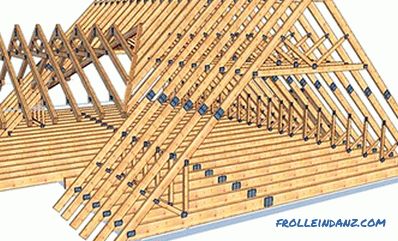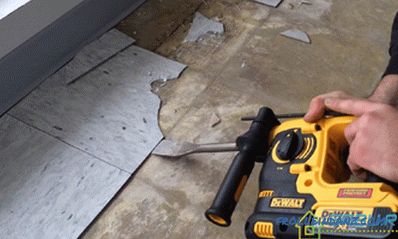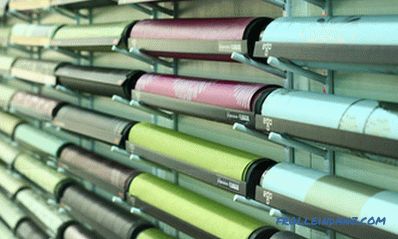When doing repairs in the toilet, the owners strive to ensure that it is functional, practical and beautiful. If there are usually no problems with the floor, side walls and ceiling, then the back wall, in which the pipes are located, makes the owners and builders think. How to close the pipes in the toilet so that they are invisible, but easily accessible? In order to deal with this issue, we compare the advantages and disadvantages of building materials, as well as how easily and quickly the structures of them are mounted.
The merits of various materials
The options for how to close a sewer pipe are actually many. You can hide pipes that warp up aesthetic taste behind a drywall box, install blinds or plastic panels.
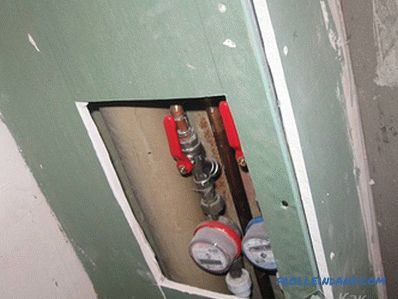 Drywall box for pipes
Drywall box for pipes
The easiest way to hide the pipes in the toilet is to close them with a box drywall. This material has the following advantages:
- Easily dismantled if necessary.
- A drywall construction is easy to install.
- Does not emit harmful substances, even if it is very hot.
- It is environmentally friendly and does not harm human health.
- Convenient for subsequent decoration. It can not only be tiled, but also painted and glued.
The lack of drywall is that if you need to repair or change the pipes, the box will have to be completely removed and rebuilt from new materials.
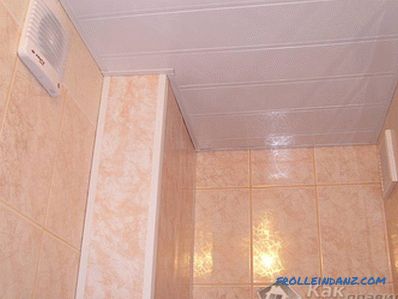 The pipes are sewn with plastic panels
The pipes are sewn with plastic panels
In order to hide the pipes in the toilet, they will work well plastic panels having such advantages:
- Easily mounted on the frame.
- Safe for human health.
- Provide access to pipes in an emergency, without requiring complete dismantling of the wall.
- Have a long service life.
- Not afraid of moisture and hygienic.
- Quickly dismantled in case of urgent need. For example, when conducting a new repair.
Lack of plastic - can strongly stand out from the side walls. Therefore, it is necessary to carefully select the plastic under the color of the tile or wallpaper.
 Blinds in the toilet
Blinds in the toilet
Blinds are well suited for small toilets. This is the cheapest option to close the pipes. Blinds will allow:
- Save space.
- Easily and quickly close the back wall.
- Close the rear wall completely or partially.
- Provide quick access to water meters or pipes.
- Place shelves in the niche for storing household equipment and cleaning products.
Lack of blinds - they can quickly turn yellow or darken. Therefore, they must be mounted so that there is an opportunity at any time to replace them with new ones, without re-doing repairs in the toilet.
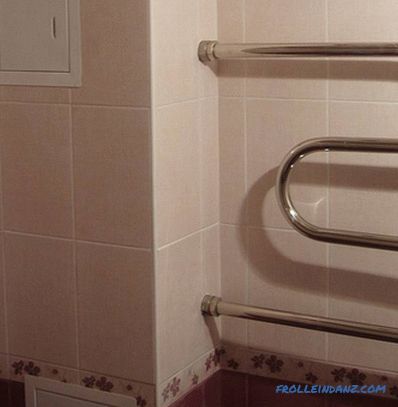 The box is sheathed with tiles
The box is sheathed with tiles
At the box, which is at least often used to hide pipes in the toilet, there are also advantages:
- If it is ready, then it remains only to mount it.
- If the features of the rear wall do not allow you to purchase a finished box, you can make it yourself. Special difficulties, if it is not multi-level, with its installation does not arise.
- This is usually a removable design.
The lack of a box is often a very voluminous structure. In the event of an emergency quickly remove the box is not always possible.
Methods for mounting various designs closure of pipes in the toilet uncomplicated. To build such a structure can even inexperienced builder. The basis of the design is made of metal profile or wooden bars. Then, depending on what will be used to mask the pipes, it is sheathed with the appropriate building material - in whole or in part.
If the pipes are closed by a box, the structure may be sheathed with plastic panels, sheets of waterproof plywood or drywall. On the drywall is usually glued tile. This is done so that the back wall does not stand out against the background of the side walls and the floor lined with tiles. The box can be bought ready-made and mounted on the back wall of the toilet. But this option can be more expensive than making a box of drywall or plywood. And you have to tinker with the pipes connected to the toilet.
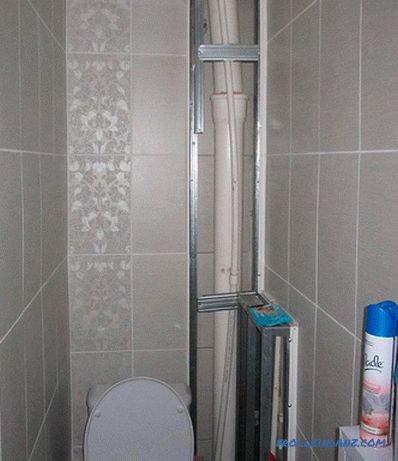 Box
Box
The box can be of several configurations:
- B a false wall. If the toilet is small in size, it is better to do the toilet. Access to the pipes due to the false wall will be difficult.
- Square. If the risers are in the same corner. The window is made at the level of valves and counters, which gives access to them at any time.
- In the form of an oblique false-wall. It is made at an acute angle to the back or one of the side walls.This box can be closed thinner pipes that sideways away from the main riser. To mount the box on the whole wall in this case does not make sense - you can simply “mow down” the one that already exists.
- Multi-level. It is mounted if the pipes in the toilet are located so that in order to close them, it is necessary to isolate half of the toilet space. This box closes at a certain height a specific part of the pipe or pipes.
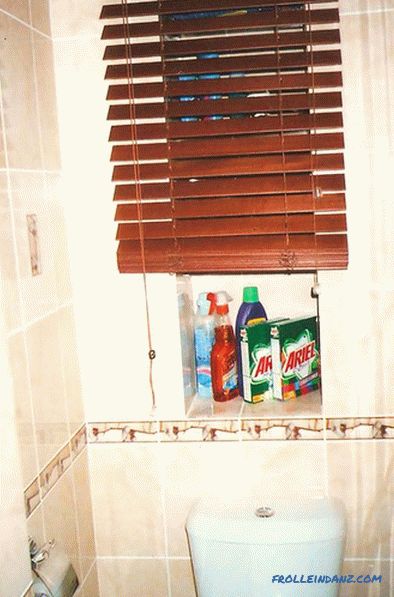 Blinds in the toilet close the niche with pipes
Blinds in the toilet close the niche with pipes
The back wall can be completely lined with plastic panels . They are mounted on a special frame with the use of metal profiles or wooden bars. First, markup is made on the back wall. Then fasten profile guides. After that - the profile is installed on the side walls - the frame for the panels is obtained. Profiles are attached to the walls with dowel-nails and perforator. The distance between fasteners should be 30‒40 cm. After the profile is fully assembled, panels are attached to it with self-tapping screws.
If the box is made under blinds, then its main part is mounted to the ceiling. At the same time, the back wall can be closed completely by blinds - from the ceiling to the floor or partially. If the blinds cover the wall partially, the box will have side panels.
Whatever the back wall has been lined with, it is imperative that you schedule an opening window for accessing the pipes. The window can be of different sizes. It must comply with the design and provide full access to pipes and meters.
Choice of design
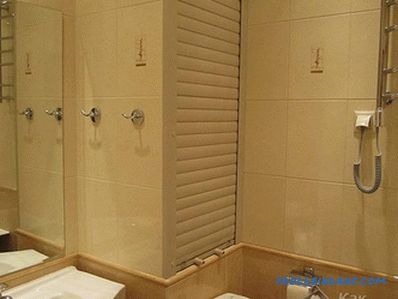 Rollers in the toilet
Rollers in the toilet
Each of the listed materials has its advantages and disadvantages. So the better to close the pipes in the toilet? It is necessary to choose the material based on the overall design idea and the means available.
If there is not enough money, it is better to stay on blinds or plastic panels. Put the tiles on the floor, paste over the side walls. And the back wall with the ceiling sheathed with plastic panels or close the blinds.
If the owners are not constrained by the means, then the toilet can be tiled completely. A pipe on the back wall to close the drywall.
In any case, how to hide the pipes on the back wall is up to the owners. Regardless of which building material they stop on, it should be remembered that before installing the frame and its covering it is necessary:
- Replace old pipes with new ones.
- Ensure that there are no defects in the pipes.
- Eliminate defects if they are detected.
- To ensure that the tees, angles, couplings and other transition elements are made of the same material as the pipes - this will reduce the likelihood of emergencies due to temperature differences in the pipes.
And what material or method have you chosen to hide the pipes in the toilet? You may have already had to do repairs in the toilet more than once, and there are some tricks. If so, then share with us.
Photos
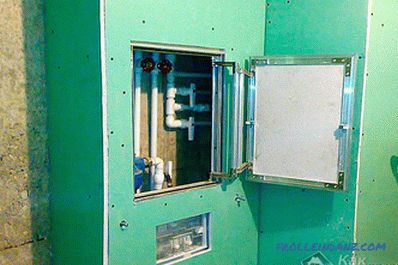 Plasterboard communications plastering
Plasterboard communications plastering
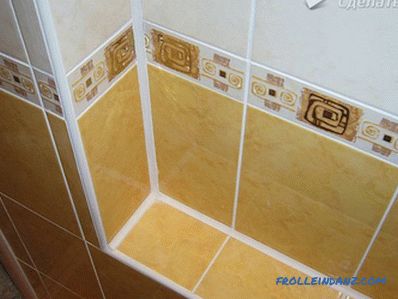 A box for pipes in a bathroom of tile
A box for pipes in a bathroom of tile
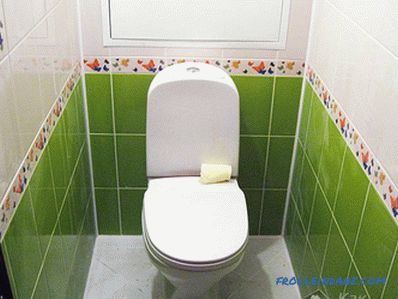 A box of plasterboard is sheathed with tiles
A box of plasterboard is sheathed with tiles
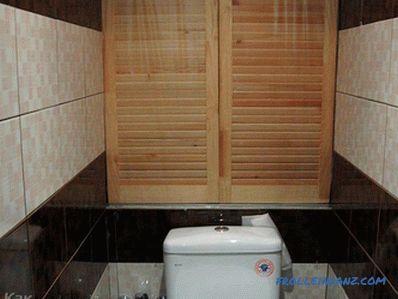 Cabinet in the toilet
Cabinet in the toilet
 Blinds in closet
Blinds in closet
Video
in the toilet This video shows how to install the roller blinds in the bathroom:
This video will show the stages of repairing a bathroom. You will learn how to close the pipes in the toilet with drywall:


